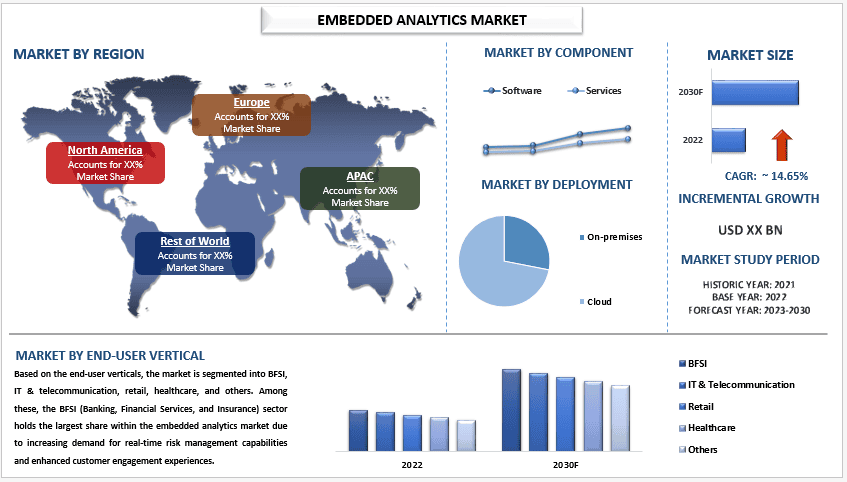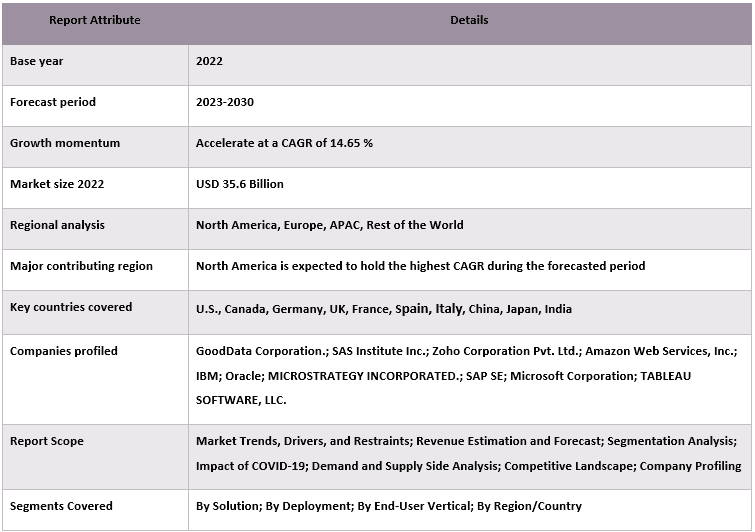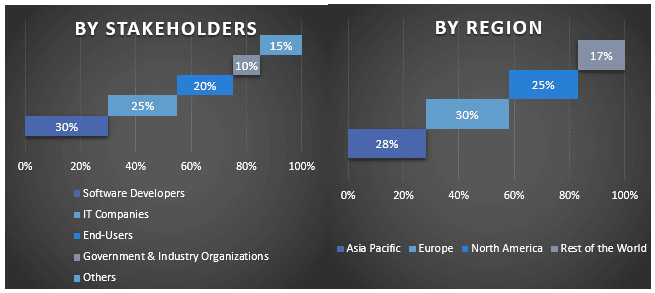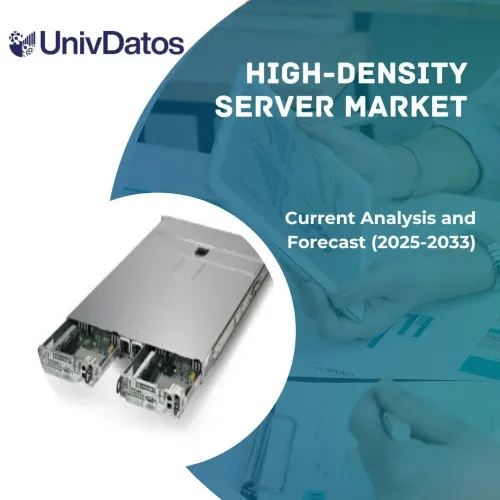- Startseite
- Über uns
- Industrie
- Dienstleistungen
- Lesen
- Kontaktieren Sie uns
Markt für Embedded Analytics: Aktuelle Analyse und Prognose (2023-2030)
Schwerpunkt auf Lösung (Software und Dienstleistungen), Bereitstellung (Online-Prämissen und Cloud), Endbenutzervertikal (BFSI, IT & Telekommunikation, Einzelhandel, Gesundheitswesen, Sonstige) und Region/Land

Der Markt für Embedded Analytics wurde 2022 auf 35,6 Milliarden US-Dollar geschätzt und wird im Prognosezeitraum (2023-2030) voraussichtlich mit einer stabilen Rate von rund 14,65 % wachsen, was auf die steigende Anzahl datengesteuerter Unternehmen zurückzuführen ist.Embedded Analytics bezieht sich auf die Integration von Datenanalysetools und -funktionen in andere Softwareanwendungen oder -plattformen. Dies ermöglicht es Benutzern, auf Daten zuzugreifen und diese zu analysieren, ohne die von ihnen verwendete Anwendung verlassen zu müssen. Das Ziel von Embedded Analytics ist es, Einblicke zu liefern und datengestützte Entscheidungsfindung direkt im Kontext von Geschäftsprozessen zu ermöglichen. Darüber hinaus wird der Markt für Embedded Analytics auch durch das steigende Bedürfnis der Benutzer nach mehr Kontrolle über ihre Datenanalyse- und Visualisierungstools angetrieben, wobei viele anpassbare und Self-Service-Optionen suchen. Darüber hinaus kann die Einbeziehung von Embedded Analytics-Funktionen in Apps potenziell zu neuen Einnahmequellen oder Upselling-Möglichkeiten führen, was die Akzeptanz weiter ankurbelt.
Zu den wichtigsten Akteuren auf dem Markt gehören GoodData Corporation.; SAS Institute Inc.; Zoho Corporation Pvt. Ltd.; Amazon Web Services, Inc.; IBM; Oracle; MICROSTRATEGY INCORPORATED.; SAP SE; Microsoft Corporation; TABLEAU SOFTWARE, LLC.
In der Bericht dargestellte Erkenntnisse
„Unter den Lösungen hält das Softwaresegment im Prognosezeitraum den größten Marktanteil.“
Basierend auf der Lösung ist der Markt in Software und Dienstleistungen unterteilt. Davon dominiert das softwarebasierte Segment den Markt für Embedded Analytics, wobei prominente Akteure wie Tableau Software, Inc., Splunk Inc. und IBM Corporation robuste Tools für Datenvisualisierung, Echtzeitüberwachung und prädiktive Analyse anbieten. Darüber hinaus tragen kontinuierliche innovative Funktionen der Softwareanbieter weiter zum Wachstum des Segments bei.
„Unter den Bereitstellungen hält das Cloud-Segment im Prognosezeitraum einen erheblichen Anteil.“
Basierend auf der Bereitstellung ist der Markt in On-Premises und Cloud unterteilt. Davon führt das Cloud-Segment derzeit den Markt für Embedded Analytics basierend auf der Bereitstellung an. Immer mehr Unternehmen wechseln zu Cloud-basierten Lösungen, da diese Vorteile wie geringere Vorabkosten, einfache Wartung, automatische Updates und Flexibilität bei der Auf- oder Abwärtsskalierung bieten. Cloud-Bereitstellungen ermöglichen auch eine nahtlose Zusammenarbeit in Teams weltweit und bieten gleichzeitig einen besseren Zugriff von Remote-Standorten aus.
„Nordamerika wird einen erheblichen Marktanteil halten.“
Die nordamerikanische Region verzeichnete ein rasches Wachstum im Bereich Embedded Analytics, was auf Faktoren wie frühe Akzeptanzraten in Verbindung mit technologischen Fortschritten zurückzuführen ist, die Innovationen vorantreiben, sowie auf den zunehmenden Wettbewerb zwischen Unternehmen, die Wettbewerbsvorteile durch fundiertere Entscheidungsprozesse suchen, die durch die Integration fortschrittlicher Analysetools in bestehende Systeme anstelle von eigenständigen Anwendungen oder manuellen Verfahren ermöglicht werden. Darüber hinaus haben staatliche Initiativen, die sich auf die digitale Transformation in allen Branchen konzentrieren, zu größeren Investitionen in die Modernisierung der Legacy-Infrastruktur geführt, was zu einem Umfeld geführt hat, das für die breite Akzeptanz von Analytikangeboten der nächsten Generation, wie sie über eingebettete Lösungen angeboten werden, prädestiniert ist. Diese Elemente schaffen zusammen einen fruchtbaren Boden für die weitere Expansion in diesem lukrativen Marktsegment.
Marktberichtsabdeckung für Embedded Analytics

Gründe für den Kauf dieses Berichts:
- Die Studie umfasst Marktabschätzungen und Prognoseanalysen, die von beglaubigten Branchenexperten validiert wurden.
- Der Bericht bietet einen schnellen Überblick über die Gesamtleistung der Branche auf einen Blick.
- Der Bericht enthält eine eingehende Analyse prominenter Branchenkollegen mit einem primären Fokus auf wichtige Finanzkennzahlen, Produktportfolio, Expansionsstrategien und aktuelle Entwicklungen.
- Detaillierte Untersuchung von Treibern, Einschränkungen, wichtigen Trends und Chancen, die in der Branche vorherrschen.
- Die Studie deckt den Markt umfassend über verschiedene Segmente ab.
- Detaillierte Analyse der Branche auf regionaler Ebene.
Anpassungsoptionen:
Der globale Markt für Embedded Analytics kann weiter nach Bedarf oder nach einem anderen Marktsegment angepasst werden. Darüber hinaus versteht UMI, dass Sie möglicherweise Ihre eigenen Geschäftsanforderungen haben, daher können Sie uns gerne kontaktieren, um einen Bericht zu erhalten, der Ihren Anforderungen vollständig entspricht.
Inhaltsverzeichnis
Forschungsmethodik für die Embedded Analytics-Marktanalyse
(2023-2030)
Die Analyse des historischen Marktes, die Schätzung des aktuellen Marktes und die Prognose des zukünftigen Marktes des globalen Marktes für Embedded Analytics waren die drei Hauptschritte, die unternommen wurden, um die Akzeptanz des Marktes für Embedded Analytics in den wichtigsten Regionen weltweit zu erstellen und zu analysieren. Um die historischen Marktzahlen zu sammeln und die aktuelle Marktgröße zu schätzen, wurden umfassende Sekundärrecherchen durchgeführt. Zweitens wurden zahlreiche Erkenntnisse und Annahmen berücksichtigt, um diese Erkenntnisse zu validieren. Darüber hinaus wurden auch umfassende Primärinterviews mit Branchenexperten entlang der Wertschöpfungskette des globalen Marktes für Embedded Analytics geführt. Nach Annahme und Validierung der Marktzahlen durch Primärinterviews haben wir einen Top-Down-/Bottom-Up-Ansatz angewendet, um die gesamte Marktgröße vorherzusagen. Danach wurden Marktaufschlüsselungs- und Datentriangulationsmethoden angewendet, um die Marktgröße von Segmenten und Untersegmenten der betreffenden Branche zu schätzen und zu analysieren. Detaillierte Methodik wird im Folgenden erläutert:
Analyse der historischen Marktgröße
Schritt 1: Detaillierte Untersuchung von Sekundärquellen:
Detaillierte Sekundärstudien wurden durchgeführt, um die historische Marktgröße des Marktes für Embedded Analytics über interne Unternehmensquellen wie zu erhaltenJahresberichte & Finanzberichte, Performance-Präsentationen, Pressemitteilungen usw.,und externe Quellen einschließlichJournale, Nachrichten & Artikel, Veröffentlichungen der Regierung, Veröffentlichungen von Wettbewerbern, Branchenberichte, Datenbanken von Drittanbietern und andere glaubwürdige Veröffentlichungen.
Schritt 2: Marktsegmentierung:
Nachdem wir die historische Marktgröße des Marktes für Embedded Analytics erhalten haben, führten wir eine detaillierte Sekundäranalyse durch, um historische Markteinblicke und -anteile für verschiedene Segmente und Untersegmente für die wichtigsten Regionen zu sammeln. Die wichtigsten Segmente sind im Bericht als Lösung, Bereitstellung und Endbenutzervertikal enthalten. Weitere Analysen auf Länderebene wurden durchgeführt, um die Gesamtakzeptanz von Testmodellen in dieser Region zu bewerten.
Schritt 3: Faktorenanalyse:
Nachdem wir die historische Marktgröße verschiedener Segmente und Untersegmente ermittelt hatten, führten wir eine detaillierteFaktorenanalysedurch, um die aktuelle Marktgröße des Marktes für Embedded Analytics zu schätzen. Darüber hinaus führten wir eine Faktorenanalyse mit abhängigen und unabhängigen Variablen wie verschiedenen Lösungen, Bereitstellungen und der vertikalen Endbenutzer-Embedded-Analytics-Markt durch. Es wurde eine gründliche Analyse der Angebots- und Nachfrageszenarien durchgeführt, wobei die wichtigsten Partnerschaften, Fusionen und Übernahmen, Geschäftserweiterungen und Produkteinführungen im Marktsektor für Embedded Analytics weltweit berücksichtigt wurden.
Aktuelle Marktschätzung & Prognose
Aktuelle Marktgrößenbestimmung:Basierend auf umsetzbaren Erkenntnissen aus den obigen 3 Schritten kamen wir zu der aktuellen Marktgröße, den wichtigsten Akteuren auf dem globalen Markt für Embedded Analytics und den Marktanteilen der Segmente. Alle erforderlichen prozentualen Anteile, Aufteilungen und Marktaufschlüsselungen wurden unter Verwendung des oben genannten Sekundäransatzes ermittelt und durch Primärinterviews verifiziert.
Schätzung & Prognose:Für die Marktabschätzung und -prognose wurden verschiedenen Faktoren Gewichte zugewiesen, darunter Treiber & Trends, Einschränkungen und Chancen, die den Stakeholdern zur Verfügung stehen. Nach der Analyse dieser Faktoren wurden relevante Prognosetechniken, d. h. der Top-Down-/Bottom-Up-Ansatz, angewendet, um die Marktprognose für 2030 für verschiedene Segmente und Untersegmente in den wichtigsten Märkten weltweit zu erhalten. Die Forschungsmethodik zur Schätzung der Marktgröße umfasst:
- Die Marktgröße der Branche in Bezug auf den Umsatz (USD) und die Akzeptanzrate des Marktes für Embedded Analytics in den wichtigsten Märkten im Inland
- Alle prozentualen Anteile, Aufteilungen und Aufschlüsselungen der Marktsegmente und -untersegmente
- Wichtige Akteure auf dem globalen Markt für Embedded Analytics in Bezug auf die angebotenen Produkte. Außerdem die Wachstumsstrategien, die diese Akteure anwenden, um auf dem schnell wachsenden Markt zu bestehen.
Validierung von Marktgröße und -anteil
Primärforschung:Tiefeninterviews wurden mit den wichtigsten Meinungsführern (KOLs), einschließlich Führungskräften auf oberster Ebene (CXO/VPs, Vertriebsleiter, Marketingleiter, Betriebsleiter, Regionalleiter, Landesleiter usw.) in den wichtigsten Regionen, durchgeführt. Die Ergebnisse der Primärforschung wurden anschließend zusammengefasst und eine statistische Analyse durchgeführt, um die aufgestellte Hypothese zu belegen. Die Ergebnisse der Primärforschung wurden mit den Sekundärfunden konsolidiert, wodurch Informationen in umsetzbare Erkenntnisse umgewandelt wurden.
Aufteilung der primären Teilnehmer in verschiedenen Regionen

Markttechnik
Die Datentriangulationstechnik wurde eingesetzt, um die gesamte Marktabschätzung abzuschließen und präzise statistische Zahlen für jedes Segment und Untersegment des globalen Marktes für eingebettete Analysen zu erhalten. Die Daten wurden nach der Untersuchung verschiedener Parameter und Trends in den Bereichen Lösung, Bereitstellung und Endbenutzervertikalen im globalen Markt für eingebettete Analysen in mehrere Segmente und Untersegmente aufgeteilt.
Das Hauptziel der globalen Marktstudie für eingebettete Analysen
Die aktuellen und zukünftigen Markttrends des globalen Marktes für eingebettete Analysen wurden in der Studie ermittelt. Investoren können strategische Erkenntnisse gewinnen, um ihre Investitionsentscheidungen auf der in der Studie durchgeführten qualitativen und quantitativen Analyse zu basieren. Aktuelle und zukünftige Markttrends bestimmten die Gesam attractiveness des Marktes auf regionaler Ebene und boten den Industrieteilnehmern eine Plattform, um den unerschlossenen Markt zu nutzen und von einem First-Mover-Vorteil zu profitieren. Weitere quantitative Ziele der Studien umfassen:
- Analyse der aktuellen und prognostizierten Marktgröße des Marktes für eingebettete Analysen in Bezug auf den Wert (USD). Analysieren Sie auch die aktuelle und prognostizierte Marktgröße verschiedener Segmente und Untersegmente.
- Zu den Segmenten in der Studie gehören Bereiche wie Lösung, Bereitstellung und Endbenutzervertikale.
- Definition und Analyse des regulatorischen Rahmens für die Branche des Marktes für eingebettete Analysen.
- Analyse der Wertschöpfungskette mit der Präsenz verschiedener Intermediäre sowie Analyse des Kunden- und Wettbewerbsverhaltens der Branche.
- Analyse der aktuellen und prognostizierten Marktgröße des Marktes für eingebettete Analysen für die Hauptregion.
- Zu den wichtigsten Ländern der in dem Bericht untersuchten Regionen gehören der asiatisch-pazifische Raum, Europa, Nordamerika und der Rest der Welt.
- Unternehmensprofil des Marktes für eingebettete Analysen und die Wachstumsstrategien, die von den Marktteilnehmern angewandt werden, um sich in dem schnell wachsenden Markt zu behaupten.
- Detaillierte Analyse der Branche auf regionaler Ebene
Häufig gestellte Fragen FAQs
Q1: Wie groß ist die aktuelle Marktgröße und das Wachstumspotenzial des globalen Marktes für Embedded Analytics?
Q2: Was sind die treibenden Faktoren für das Wachstum des globalen Marktes für Embedded Analytics?
Q3: Welches Segment hat den größten Anteil am globalen Markt für Embedded Analytics nach Endbenutzer-Vertikal?
Q4: Welche Region wird den globalen Markt für Embedded Analytics dominieren?
Q5: Wer sind die wichtigsten Akteure, die auf dem globalen Markt für Embedded Analytics tätig sind?
Verwandt Berichte
Kunden, die diesen Artikel gekauft haben, kauften auch










